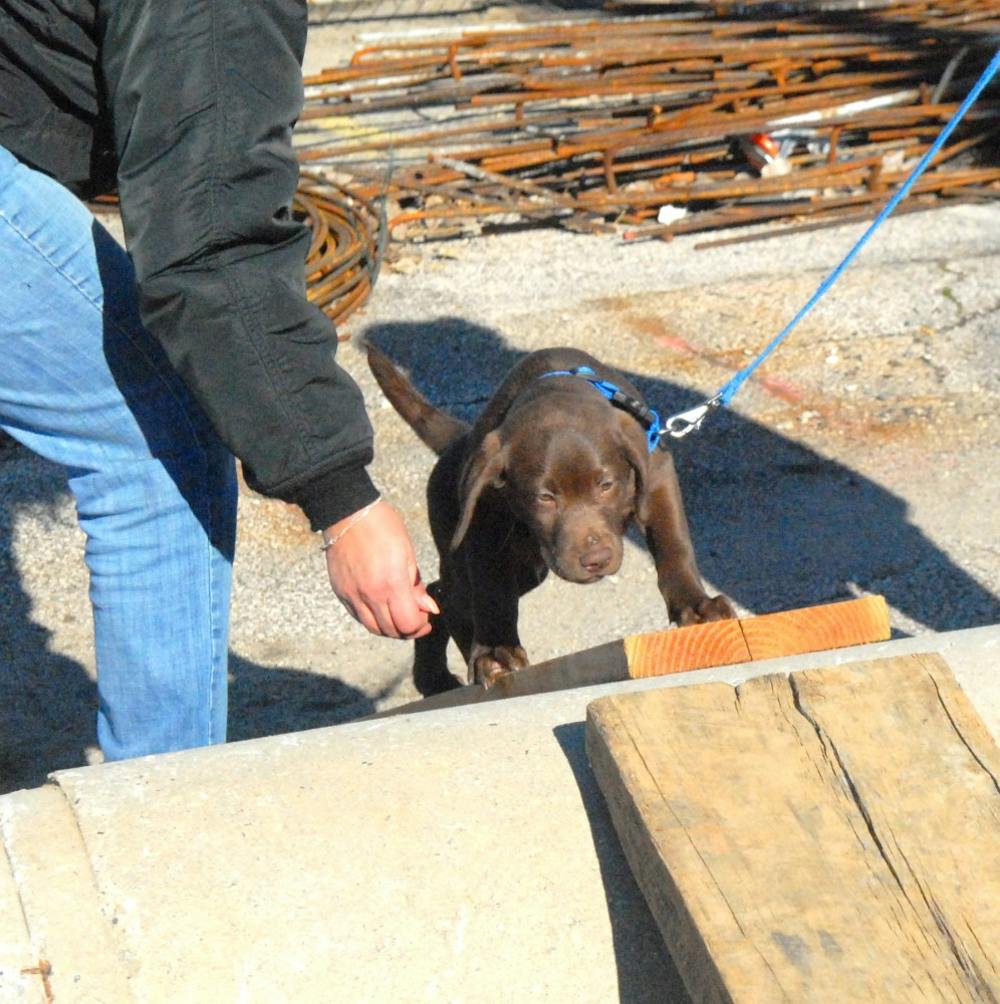
It’s just before 7 a.m. on a cold sunny morning when I arrive at Penn’s South Bank, where I am greeted by three of the puppies I had met two months ago at the Penn Vet Working Dog Center’s grand opening. Even with a quick glance, one thing is clear — Thunder, PApa Bear and Kaiserin have grown so much.
The center’s inaugural “Class of 2013” initially consisted of seven puppies donated by breeders and kennels, and each was named in honor of a 9/11 search-and-rescue dog. Two new puppies have since joined the class.
The center’s mission is to understand what makes a successful working dog, and to that end, extensive data on each puppy’s health, behavior and search skills is collected every day, according to Director of Operations Sarah Griffith.
“Breeders who donate puppies to us are interested in the science,” she said.
As I prepared for my day of helping to train the puppies, Training Director Annemarie DeAngelo offered me a mug of fresh coffee and warned me about how much dog fur would inevitably end up on my clothes. She completed my welcome by telling me that “we’re all family here.”
While waiting for the entire puppy class to arrive, I spoke with volunteer Randy Claney, who — like many of the center’s 60 volunteers — plays with the puppies at various points throughout the day in order to prevent them from playing exclusively with one another.
Between 7 and 9 a.m., the puppies’ foster parents dropped them off for their daily training activities.
Griffith said that placing puppies with foster families and starting their training at only eight or nine weeks old constitutes another area of the research, since dogs undergoing training most often sleep in kennels.
“We introduce some sweet inconsistencies by fostering,” she said. “But that’s life.”
Among the foster parents is Penn Executive Vice President Craig Carnaroli, who handed off his foster puppy Socks to a staff member and waved briefly before leaving.
In the meantime, DeAngelo went to a vacant building next door to hide pieces of a leather tug — the toy toward which the puppies have been trained to direct their drive.
Around 9 a.m., individual search training began.
First up was Socks, and I was her handler. DeAngelo instructed me to detach and hide the lead from her collar while gently stroking her neck and telling her, “Go to work, Socks, let’s go to work!”
As Socks’ innate drive kicked in, I watched for changes in her breathing. She would scan each room, opening her mouth to smell and closing it when narrowing in on the location of a hidden tug for a more intense search.
DeAngelo said that if at any point the dog’s drive begins to drop, the handler can help by systematically guiding the search, pointing at places where the dog should check while providing verbal encouragement.
Intern Ashley Crandall logs DeAngelo’s ratings of each puppy’s persistence, drive and accuracy onto a custom-designed iPad program called REDCap. Every search is also recorded on video and reviewed daily.
Socks did extremely well.
Next up was Sirius, handled by his foster mom and Children’s Hospital of Philadelphia Trauma Research Coordinator Eileen Houseknecht.
“Sirius is caffeine in puppy form,” Houseknecht said. During his searches, his focus remained sharp, and he completely ignored a ball he otherwise loves to play with.
The commitment to foster required Houseknecht to replace her red convertible car with an SUV that could fit Sirius’ kennel.
At home, foster parents are instructed to do some crate training and fitness exercises. “But we mostly just have a lot of fun,” Houseknecht said.
After search training, we led all of the puppies toward a construction area in the back of the center where they practiced safe and focused walking on rough terrain, hills, pipes and pieces of wood.
We carried treat bags attached to our waists, and frequently rewarded the puppies for obedience to commands and impulse-control behavior.
Shortly after, the puppies were led back into their respective crates. It was time for lunch.
“Do we want extremely annoying or mildly annoying lunch sign today?” Crandall asked. As a loud helicopter noise filled the room, the puppies received toys containing their carefully measured food.
Crandall explained that associating startling noises — which working dogs are likely to encounter in their roles — with a pleasant thing like lunch helps the puppies to not fear them.
DeAngelo said that finding ways to sneak training into routine activities is one of the many great things about the center.
“We have people with different canine backgrounds all putting their minds together,” she said.
After lunch, Griffith and I talked for a long time about all that search-and-rescue and therapy dogs can do.
“We’re still nowhere near the limit of what we can achieve by combining this amazing sense of smell with the amazing bond between dogs and humans,” she said. “This is the wondrous thing about this whole project.”
The Daily Pennsylvanian is an independent, student-run newspaper. Please consider making a donation to support the coverage that shapes the University. Your generosity ensures a future of strong journalism at Penn.
DonatePlease note All comments are eligible for publication in The Daily Pennsylvanian.








